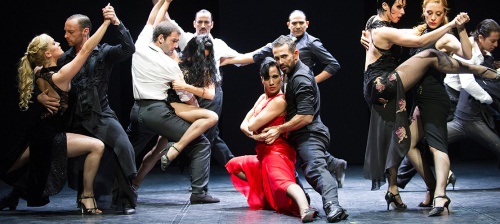milonga
ASB Theatre, Aotea Centre, Auckland
18/03/2016 - 20/03/2016
Production Details
In a nutshell:
It takes 12 to tango / Super-charged dance superstars / Passion and seduction – Argentine style
Welcome to the milonga – a celebratory party where tango dance and music are a way of being; a place of passion and unparalleled beauty.
m¡longa is genius choreographer Sidi Larbi Cherkaoui’s(Babel) and tango superstar Nelida Rodriguez de Aure’s ecstatic take on Argentine tango. Let m¡longa cast its magic spell with searing duets that defy the laws of physics, flick-knife footwork and electrifying ensemble dance.
A five-piece orchestra with bandoneon plays a score merging vintage tunes by Astor Piazzolla with newer compositions to propel 10 masterful tango dancers and two contemporary dancers on whilst state-of-the-art video design lands you smack-bang in the sass and hubbub of the streets and late-night bars of Buenos Aires.
Far more than a dance for stars, m¡longa offers the audience the chance to explore the beauty, ferocious energy and alluring intimacy of tango.
- FRI 18
8:00pm
- SAT 19
2:00pm8:00pm
- SUN 20
7:00pm
Dance ,
1 hour 35 minutes
Ultra-focussed, passionate intensity
Review by Jenny Stevenson 19th Mar 2016
In Milonga, his 2013 work created as a Sadler’s Wells production, Belgian choreographer Sidi Larbi Cherkaoui plunges into the darkly shimmering world of Argentine Tango, with its multiple forms and deeply evocative music. The work features ten highly skilled tango dancers and two contemporary dancers as well as a quartet of musicians who are on stage throughout.
The dance form is described by New Zealand writer Kapka Kassabova (now resident in Scotland) in her book Twelve Minutes of Love: A Tango Story – “…tango is art, not sex. Yes, it is art made with your body and someone else’s. But not sex.” As depicted in Milonga the tango becomes quite simply an artistic exploration of the human condition and of life’s complexities and therein lies its charm.
The magnetism of the tango dance form lies in the intensity of its performance and the dancers do not disappoint in this regard. They are ultra-focussed, passionate and totally present in each moment. Cherkaoui’s choreography, which he acknowledges has been made in conjunction with the dancers and tango consultant Nélida Rodríguez de Aure, often disrupts the traditional male/female partnering, showcasing the movement sequences in multiple differing formations –so that we in the audience begin to have an intimate knowledge of what constitutes tango. The vocabulary of walking, gliding, flicking kicks, lunges, back-falls, lifts, attitudes, freezes and numerous other steps is intriguing and the improvisatory element lends a frisson of excitement to the form.
A highlight is the trio of male dancers who suddenly invest their dance with a burst of palpable energy as they move each other through air-borne sequences and lunging poses. There is also a ferocious tango that depicts a fiery argument and its aftermath with great style. The sheer beauty of the couples’ liquid movement in several sections moves the audience to ecstatic applause.
The dancers: Martin Epherra, Damien Fournier, Esther Garabali, Marcel Giacomini, Bruno Gibertoni, Claudio Gonzalez, Roberto Leiva, Nicholas Schell, Nair Schinca, Julia Urruty, Valentina Villarroel and Jennifer White, move from partner to partner in the manner of the milonga or tango dance party and it is these changes that make the performance interesting as the different styles inter-mingle.
Cherkaoui uses a number of devices to interrupt the flow of the movement. These include a host of stationary white cut-out figures who literally people the dance floor to the accompaniment of a babble of voices. He also periodically places a single moving figure or couple against a background of street scenes projected larger than life size and dizzyingly mutating in a constant state of flux that reflects the exhilarating music that accompanies these sequences. Set and video are designed by Eugenio Szwarcer.
In addition, there is a comic sequence depicting a delicious, off-beat courtship and an interlude of more floor-based contemporary dance performed by White and Fournier.
Three composers are listed: Fernando Marzan, who is also the Musical Director, Szymon Brzóska and Olga Wojciechowska , whose compositions are played with great verve by violinist Guillermo Rubino, guitarist Alejandro Sancho, with Frederico Sanisteban on bandoneon and Roberto Santocono on bass.
Milonga leaves the audience saturated in tango both aurally and visually: it is a stimulating treat for the senses.
Copyright © in the review belongs to the reviewer





Comments